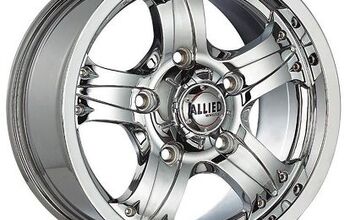Trade War Watch 16: Hot Wheels Just Got Hotter

It’s been some time since since we had a “ Trade War Watch” on mounting trade tensions in the auto industry, and thank goodness for that. In this economic climate of cuts, currency swings and bankruptcies, what we need are things which will make the situation worse, right? In May I reported about how the EU put a 20.6 percent tariff on aluminium wheels from China. The EU did this in response to complaints from domestic manufacturers. Naturally, this left a sour taste in China’s mouth. Well, over 5 months later, you’d think that the EU would have calmed down and this nasty business would be swept under the carpet, right? Erm, not quite….

More by Cammy Corrigan
Latest Car Reviews
Read moreLatest Product Reviews
Read moreRecent Comments
- Corey Lewis Facing rearwards and typing while in motion. I'll be sick in 4 minutes or less.
- Ajla It's a tricky situation. If public charging is ubiquitous and reliable then range doesn't matter nearly as much. However they likely don't need to be as numerous as fuel pumps because of the home/work charging ability. But then there still might need to be "surge supply" of public chargers for things like holidays. Then there's the idea of chargers with towing accessibility. A lack of visible charging infrastructure might slow the adoption of EVs as well. Having an EV with a 600+ mile range would fix a lot of the above but that option doesn't seem to be economically feasible.
- 28-Cars-Later I'm getting a Knight Rider vibe... or is it more Knightboat?
- 28-Cars-Later "the person would likely be involved in taking the Corvette to the next level with full electrification."Chevrolet sold 37,224 C8s in 2023 starting at $65,895 in North America (no word on other regions) while Porsche sold 40,629 Taycans worldwide starting at $99,400. I imagine per unit Porsche/VAG profit at $100K+ but was far as R&D payback and other sunk costs I cannot say. I remember reading the new C8 platform was designed for hybrids (or something to that effect) so I expect Chevrolet to experiment with different model types but I don't expect Corvette to become the Taycan. If that is the expectation, I think it will ride off into the sunset because GM is that incompetent/impotent. Additional: In ten years outside of wrecks I expect a majority of C8s to still be running and economically roadworthy, I do not expect that of Taycans.
- Tassos Jong-iL Not all martyrs see divinity, but at least you tried.


































Comments
Join the conversation
Aluminium wheels are about 1 percent of the total cost of a car, therefore, the cost increase can’t be no more that 0.22 percent according to the EU. 1%? So on a $30,000 car you can buy four new wheels at the dealer for $300? Maybe they meant each wheel was 1%!
"The EU has 501,064,211 potential customers for Chinese products. China has 1,338,612,968."
Uh, that is not the only way to look at it nor is it the most relevant. The relevant number to look at the monetary balance of trade between the EU and China.
The most recent report I was able to find quickly dates to the first half of 2009. In that period the EU exported 37 Billion Euro worth of goods to China whilst importing 103 Billion Euro worth from China. Thus, China is fact has more to loose in a trade war with the EU than does the EU.
http://epp.eurostat.ec.europa.eu/cache/ITY_PUBLIC/6-27112009-AP/EN/6-27112009-AP-EN.PDF
The issue of comparative labor and environmental standards is likewise a very real one.